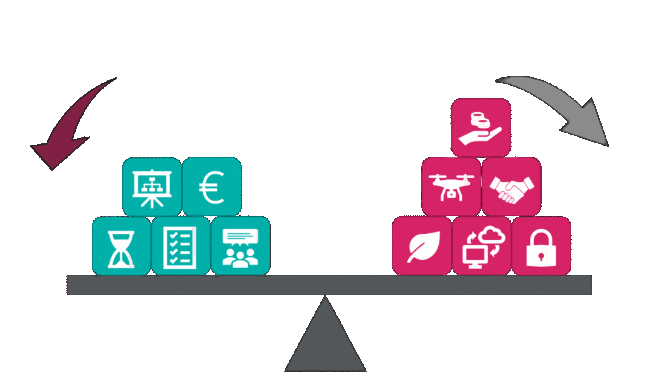The Airspace Architecture Study (AAS) provides a blueprint for removing structural inefficiencies in Europe through a process of virtualisation. However, the AAS does not consider how this process could be incentivised through economic regulation. Whilst the SES Performance and Charging Scheme has increased transparency and removed full cost recovery – it has been modest in its ability to improve cost efficiency. Whether ATM in Europe represents value for money is still a fractious question. Especially given the effects of COVID, we do not have the business environment for the necessary short term increase in investments to achieve virtualisation.
Modernisation of ATM therefore requires new regulatory and financial mechanisms that can organically incentivise a sustainable transformation in the short-term to increase network efficiency and deliver substantial performance and financial benefits in the longer term as traffic returns and exceeds previous levels.
The current regulation is limiting modernisation
Traditionally, ANSPs existed in a market with no natural competition, their performance barely monitored, and costs rarely controlled. As flying became more popular, delays increased – requiring political interventions such as the creation of the CFMU in 1995 and the Single European Sky in 2004. However performance issues persisted and prices did not fall. As a result, the Single European Sky (SES) Performance Scheme and Common Charging Scheme was born in 2009 to set economic and performance targets on the ANSPs and establish new approaches to cost recovery and risk sharing.
The SES Performance Scheme has increased transparency and harmonisation in reporting performance within the industry and supported modest improvements in performance and efficiency. However, in the case of cost efficiency progress has been largely deemed inadequate. The current approach incentivises ANSPs to increase planned capital expenditure (to increase allowed profitability) and to some degree to delay that expenditure (to increase actual profitability). The implementation of the scheme has not increased our understanding of value for money or indeed what ‘fair price’ is for the various levels of service available across Europe. And of course, the COVID crisis has exposed the risk sharing mechanisms as inadequate for severe drops in traffic. A better form of economic regulation is clearly required – but one that incentivises modernisation not just optimisation of the current system.
Implementing the AAS requires a new approach
The current monopolistic en-route ATM market has had little scope for competition to incentivise efficient performance. The service provision market is fragmented, resistant to change, has high charges and widely varying performance between ANSPs across Europe due to different service requirements, traffic complexity, inefficiencies and high staff and pension costs. There are therefore very high barriers of entry to the market – both in terms of the national current monopoly derived but also infrastructure costs.
The AAS provides a technical blueprint to allow the current vertically integrated monoliths to be broken up and horizontally re-integrated to make better use of economies of scale.
This requires a new approach to economic regulation – to incentivise both organisational and technological transformation to ensure the future system is capable of reaping the benefits of digitalisation to deliver increased capacity in a safe, environmentally optimised and cost efficient manner.
Using economic regulation to support this level of transformation in ATM is a significant challenge. However, other similar industries such as the water and telecommunication industries in the UK have achieved successful transformation through effective regulation and even the introduction of competition within previously monopolistic markets. The ATM industry can learn from these experiences.
Driving cost efficiency in ATM
The AAS effectively envisages three distinct markets:
-
-
- Air Traffic Services Layer – provision of ATS through the Virtual Centre concept (think ATCOs in ACCs controlling traffic).
- Common Data Layer – provision of ATM Data services and Integration services (think cloud-based data services provided as scale).
- Physical Layer – provision of CNS, AIS and MET services (think physical assets with coverage optimised over a wider geographic scope).
-
Each of these markets requires different organisational structures (systems, buildings, staff) delivering different types of service and therefore may reach efficiency by a different combination of competition, collaboration and regulation.
![]()

Introducing competition in the ATM market will incentivise greater performance as entities strive to sustain and grow market power/share, resulting in downward pressure on prices and increased productivity. Competition tends to create more efficiency and better-quality service, as entities are encouraged to shift to a more customer-centric approach in order to attain a better reputation than their competitors.
To successfully introduce competition between firms we need to consider the notion of contestability. A contestable market has low barriers to entry and no sunk costs allowing new firms to easily enter/exit the industry.
Each of the three AAS layers could be established as a contestable market – although careful consideration is required to ensure that the oversupply of assets to enable competition is not greater than the benefits of competition. The common data layer is perhaps the easiest to consider as competitive market since rationalisation of FDP/RDP is a significant cost saving and entities like Microsoft and Google demonstrate that cost efficient provision of highly reliable data services is very possible. The same can also be said on the physical layer – mobile phone companies demonstrate the benefits of competition – but some forms of behaviour have required regulation to save us from high roaming charges.
Establishing a contestable market to enable competition may not always be achievable or desirable and this is where regulation plays a vital part in controlling activity within the market. Monopoly markets must face strict regulation to encourage fairer conduct and more productive performance.
The SES Performance and Charging Scheme provides regulatory measures to tackle cost inefficiency of ANSPs, but they will require an overhaul. Assuming the ATS layer remains a monopoly (or at least an insufficiently contestable market) the form of regulation would still need to adapt to take account of the new organisational structure. An ANSP buying ATM data and CNS services will have lower CAPEX and higher OPEX (e.g. subscriptions to the underlying services) suggesting that switching to a TOTEX (total expenditure) approach may be more beneficial than the current approach and successfully tackle the capex bias challenge by providing greater scope for making efficient capex-opex trade-offs. This approach to price control has already been successfully applied in markets with similar characteristics such as the utilities industry within Italy and the UK.
The AAS, however, enables dynamic allocation of airspace to the area control centres within a Virtual Centre. The nature of this allocation could be competitive (for example mediated by a Capacity Broker as studied in COCTA) or collaborative.
In the collaborative approach, a group of ANSPs are effectively working together to reduce costs and improve cost efficiency. The regulator will still need to understand the costs in order to regulate the price of the services provided to ensure that potential clients are receiving value for money. An enlightened regulator, seeing benefits in this approach equivalent to the benefits of a contestable market, may decide on a less burdensome form of regulation designed to incentivise the collaboration.
Where next?
We need to look to the future. ATM needs to reap the benefits of digitalisation – both to ensure that aircraft are able to fly the most environmentally-friendly routes, at the least possible cost whilst maintaining high levels of safety.
We have to recognise that the current monopolistic national ANSPs don’t provide the technical solution for this level of optimisation. But we also have to allow States to retain their sovereign rights over airspace. Virtualisation is the right technical solution to enable modernisation whilst allowing Member States to retain national area control centres and ability to control their own airspace when required whilst contributing to a seamless and harmonised service provision optimised for the network.
We have to recognise that our current approaches to economic regulation will not support this transition. We need new thinking and consensus on whether regulation, collaboration or competition will best drive us forward.


Author: Maribel Tomás, ATM Consultant Author: Rifayat Mirza, ATM Intern


Recent Comments